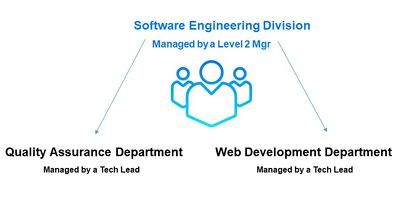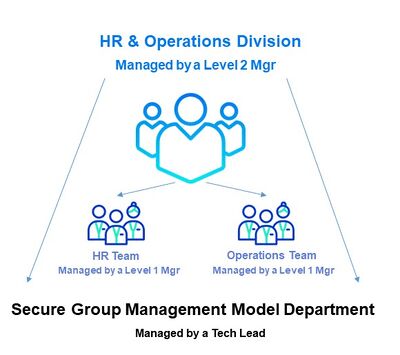Leadership
With a complex organization like ours, we need capable leaders to ensure we are heading in the right direction and that any changes throughout the organization will be handled effectively, with minimum disruption to our performance. This is no simple task, and our solution is a diversified leadership structure, where every leader is focused on completing their tasks, which contributes to our overall performance. We will introduce how we structure our teams and how we differentiate our leaders, as well as how a manager can move up through our organization.
Levels and Steps
Any path in Secure Group is separated into Levels and Steps, to make the process of promoting high performers well-structured and easy to understand. Our Management Path has four Levels, and each Level has four Steps that you can grow into. A leader at each level and step would have different responsibilities, core duties and objectives and would focus on different aspects of our operations. How an employee can move from one level or step to can be found here.
Teams Structure
Before we dive into how we approach leadership, it’s worth clarifying how we structure our teams. They are divided into Divisions, Teams and Departments.
- Division: this is the top-level structure, managed by a Level 2 manager. In some cases, the employees under a Division can be separated into teams.
- Teams: teams make up a division, and are managed by a Level 1 manager, who is responsible for the coordination of processes, and a Level 2 manager, who is responsible for the team’s growth.
- Department: each Department is composed of a group of frameworks and managed by a Tech Lead, who is responsible for the processes and documentation.

For example, a division can be the HR & Operations Division, which would have the HR Team and Operations Team under it, and would be made up of the Secure Group Management Model Department.

Leadership Roles
At Secure Group, we have two types of leaders: Managers and Tech Leads.
A Tech Lead is the leader in terms of operations. They are a subject matter expert that has mastered the department’s processes and tools. Their main goal is to support each department in the effective execution of its tasks and to help the team members progress in their careers.
Their tasks also include managing the department’s standard operating procedures in Confluence (our internal wiki), and to ensure cross-department processes are well-documented and understood on an organizational level. As they are experts in their field, they are in charge of the knowledge transfer in their department, which involves onboarding new employees.
Who can become a tech lead? It can be an Individual Contributor Level 3 and UP, or a manager Level 1 or Level 2, Step 1 or 2. A manager at Level 2 Step 3 and above should have already grown another member of their team to be a Tech Lead, and be able to move on from being a Tech Lead themselves.
A manager is more focused on career management within a department. They have a say in making strategic decisions and frameworks but also work on a more personal level with teams and individuals to promote excellence and teach new skills.
| Leadership | Responsibility | Activities | Focus |
|---|---|---|---|
| Manager | Growth of Individuals |
|
Performance
|
| Tech Lead | Technology (Subject Matter Expert) |
|
Processes Improvement
|
Traits of leadership
Secure Group operates on a “Context, Not Control” mantra, and that applies to our leadership model too. Even in this environment, we need people to provide guidance and directions, but in a way that empowers employees, rather than controlling them. To ensure our leaders are well-equipped for the task, they need to share a few core qualities:
1. They are adaptive
When there is a disruption in our work or a certain aspect of our work becomes uncertain, we expect our leaders to be able to realign our teams towards success.
2. They value diverse opinions
They seek out the opinions of the team members and value everyone’s contributions.
3. They cultivate a culture of trust
At Secure Group, we want our high performers to feel free to do their best work, and this is only possible when their leaders trust in them.
4. They develop other leaders
Good leaders pass on their knowledge and experience and look to replicate their mindset throughout the organisation.
5. Encourage
Proactiveness and positivity are contagious, and we want our leaders to spread them among the teams.
6. Sell instead of tell
Good leaders need to inspire and encourage action, instead of demanding it out of others.
7. They think you, not me
Our leaders need to be team players and think how they can benefit everyone, not themselves.
8. They think long-term
Leaders need to have their sights set to the future and be able to make decisions with a long-term perspective.
9. Act with humility
Leaders should lead by example and not exert their dominance over others or act superior.
Management Levels
At Secure Group we don’t have a “leader-first” approach. For us, a successful manager’s main goal is to support the organization and its people and address its needs where necessary, instead of aiming for material gain or influence.
To ensure our managers can focus on the right tasks that move our mission forward and that they can carry on improving their skills, we’ve separated four different Levels in the Management Path.
- Level 1 – Our pace setters
These leaders are primarily focused on performance and delivering results. They set high standards for themselves and their colleagues and hold them accountable for hitting the team’s goals. Their work can often get complex and involve many different stakeholders and teams, which means they need to be exceptional at communicating and manage chaos and change.
- Level 2 – Our coaches
They are responsible for the performance of their teams and/or divisions and helping their subordinates grow. They need to have a strategic outlook and be able to foresee issues and solve problems that don’t have a clear solution. They need to assess the strengths and weaknesses of their team members and promote growth and give performance feedback. Usually manage a small division.
- Level 3 – Our visionaries
The Level 3 managers are responsible for guiding our divisions’ strategic direction at a high level. They monitor the marketing and ensure Secure Group retains its competitive advantage. These managers direct our divisions and eliminate any knowledge gaps that may exist. They have the ability to inspire people on a large scale and boost employee morale. Overall, they help the company grow, unite teams and help improve what is not working.
- Level 4 – Our transformational leaders
Level 4 managers set the company’s strategic direction, develop context, and are responsible for fostering our corporate culture on an organizational level. They manage multiple Divisions and take care of the company’s growth by training the next generation of Secure Group leaders. They use outstanding adaptive leadership skills to manage big shifts in the company while keeping good relationships with the shareholders and maintaining the company’s ethics and culture.
Leaders Performance
We encourage our leaders to always aim higher and move from one Level and Step to another. To make sure they are ready for the move, we evaluate them during our Level & Step reviews, based on four criteria: Technical leadership, Business leadership, Career management leadership and Adaptive leadership. Each of those is further divided into Completeness and Achievement sections.
1. Technical leadership This refers to the technical competencies of our leaders and is closely tied to our Process Management, Knowledge Management and Team Management models. The Completeness section refers to the leaders’ management of processes – how they set them up, improve and adapt them. Achievement relates to performance and guaranteeing people are accountable and are constantly improving and adapting the required technical knowledge.
2. Business leadership This refers to managing our strategy, overcoming strategic challenges and setting up context for subordinates and stakeholders. Here Completeness refers to the leader’s contribution to creating strategic maps and defining and monitoring KPIs. Achievement is related to a leader’s ability to utilise teams to their maximum potential and achieve goals and KPIs.
3. Career management This criteria is all about a leader’s ability to understand and manage people. Completeness refers to the successful mapping of positions in the company to achieve our performance goals. Achievement is connected to having the right people assigned to the right positions and that they are given the opportunity to constantly grow and develop.
4. Adaptive leadership In a fast-moving company like Secure Group, things can change quickly and bring a certain amount of chaos. Those situations require our staff to adapt fast, which can be a challenge. These are the situations in which a true leader can shine. We consider 6 perspectives for success in this issue:
- Get on the balcony – this is the leader’s ability to distance themselves from the situation and take a birds-eye view. This allows them to see the bigger picture and act in an objective way, which is most beneficial to the company.
- Identify adaptive challenges – finding opportunities that require people to learn in an adaptive way and open their mind to new possibilities and way of doing things.
- Regulate distress – supporting the transition of employees during challenging times of change, by managing the pressure on them and their stress.
- Maintain disciplined attention – to ensure maximum focus, a leader should bring attention to what is important and shield the team from disruptive distractions.
- Get the work done – motivating people and directing the workflow to make sure the work is done efficiently.
- Protect voices from below – be inclusive and allow the opportunity to experiment to everyone.
Regardless of their Level or Step, leaders in Secure Group have a crucial role in the operation of Secure Group. Just as with other employees, they are held accountable for their work and their performance, and only through excelling at their tasks can they rise up the Management Path. Our requirements are challenging, but only because excellent leadership is so important to our organisation.